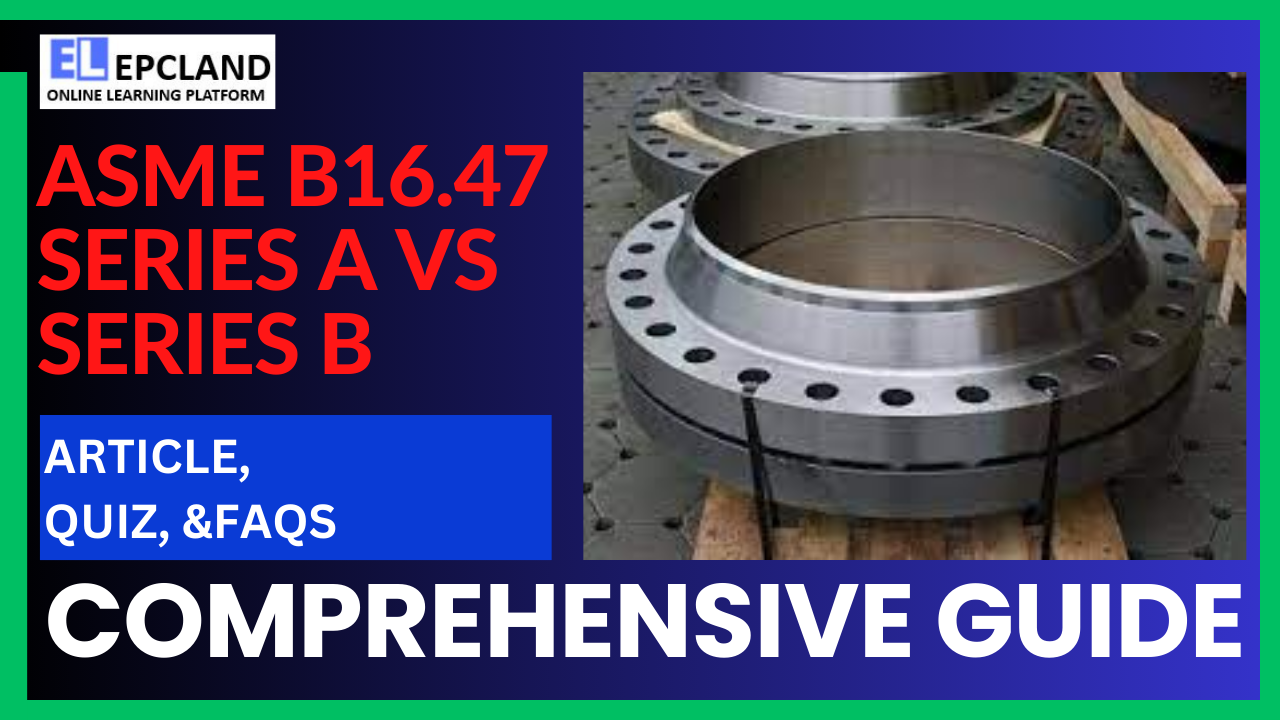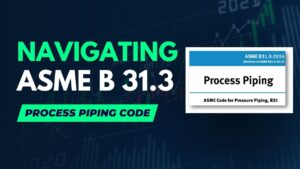The American Society of Mechanical Engineers (ASME) has established standards that play a crucial role in the design, manufacturing, and maintenance of industrial equipment and components. Among these standards, ASME B16.47 Series A and Series B are significant in the context of flanges. These standards govern the dimensions and specifications for large diameter steel flanges, and understanding the differences between Series A and Series B is essential for engineers and professionals in various industries. In this article, we will delve into the specifics of ASME B16.47 Series A and Series B, comparing their features and applications.
Table of Contents
Don’t miss the Complete Course on Piping Engineering: Check Now
Enrollment Link
I. Introduction
Large diameter flanges are essential components in various industries, including oil and gas, petrochemical, and power generation. They are used to connect pipes, valves, and other equipment, ensuring the safe and efficient transport of fluids. ASME standards provide guidelines for the design and manufacturing of these flanges. Two notable standards within the ASME B16.47 series, Series A and Series B, offer distinct specifications. Understanding their differences is crucial for selecting the right flange for a given application.
II. ASME B16.47 Series A: An In-Depth Overview
A. Background and History
ASME B16.47 Series A is a set of guidelines for large diameter steel flanges. It has a rich history and has been widely adopted in various industries.
B. Key Features of ASME B16.47 Series A
ASME B16.47 Series A is known for several distinguishing features:
1. Flange Sizes
- ASME B16.47 Series A covers flange sizes ranging from 26 inches to 60 inches. This makes it suitable for applications that require larger diameter flanges.
2. Pressure Ratings
- Series A flanges are designed for pressure ratings of 150, 300, 400, 600, 900, and 1500. These ratings are suitable for high-pressure applications.
3. Weld Neck and Blind Flanges
- Series A includes weld neck and blind flanges, which are commonly used in industries requiring high-pressure and critical applications.
C. Applications of ASME B16.47 Series A
ASME B16.47 Series A flanges find applications in industries with demanding requirements, including:
1. Petrochemical Industry
- Series A flanges are used in the construction of pipelines, heat exchangers, and pressure vessels in the petrochemical industry.
2. Oil and Gas Industry
- Offshore oil and gas platforms, refineries, and pipelines utilize Series A flanges due to their robust design and high-pressure ratings.
III. ASME B16.47 Series B: A Comprehensive Overview
A. Background and History
ASME B16.47 Series B is another important standard within the ASME B16.47 series, offering a different set of specifications for large diameter steel flanges.
B. Key Features of ASME B16.47 Series B
ASME B16.47 Series B is notable for the following features:
1. Flange Sizes
- Series B covers flange sizes ranging from 26 inches to 60 inches, similar to Series A.
2. Pressure Ratings
- Series B flanges are designed for lower pressure ratings, typically 75, 150, 300, 400, 600, and 900. These ratings are suitable for applications with lower pressure requirements.
3. Weld Neck and Blind Flanges
- Series B also includes weld neck and blind flanges, making it versatile for various applications.
C. Applications of ASME B16.47 Series B
ASME B16.47 Series B flanges are commonly used in industries with lower pressure requirements, including:
1. Water and Wastewater Treatment
- Series B flanges are suitable for connecting large pipes in water treatment facilities and distribution networks.
2. General Manufacturing
- Industries that do not require high-pressure connections often use Series B flanges due to their cost-effectiveness.
Don’t miss the Complete Course on Piping Engineering: Check Now
Enrollment Link
IV. A Comparative Analysis: ASME B16.47 Series A vs. Series B
ASME B16.47 Series A and Series B are two closely related but distinct standards within the American Society of Mechanical Engineers (ASME) B16.47 series. They both pertain to large diameter steel flanges, which are critical components used to connect pipes, valves, and other equipment in various industrial applications. Understanding the differences between these two standards is essential for engineers and professionals tasked with selecting the appropriate flange standard for their specific needs.
1. Size and Pressure Ratings
Both Series A and Series B standards encompass flanges with the same size range, typically ranging from 26 inches to 60 inches. This size range makes them suitable for applications where larger diameter flanges are necessary to accommodate the flow of fluids or gases. The key distinction between the two lies in their pressure ratings:
- ASME B16.47 Series A is designed for high-pressure applications and offers pressure ratings of 150, 300, 400, 600, 900, and 1500. This makes Series A flanges ideal for industries and processes where maintaining high-pressure integrity is critical, such as in the petrochemical and oil and gas sectors.
- ASME B16.47 Series B, on the other hand, caters to applications with lower pressure requirements. The pressure ratings for Series B flanges typically include 75, 150, 300, 400, 600, and 900. Series B flanges are more commonly found in industries where high-pressure requirements are not a primary concern.
2. Industry Specificity
The choice between ASME B16.47 Series A and Series B flanges often depends on the specific industry and application requirements.
- ASME B16.47 Series A is frequently used in industries with stringent pressure requirements and applications that necessitate the highest level of safety and reliability. The petrochemical industry and the oil and gas sector, where pipelines, heat exchangers, and pressure vessels are subject to extreme pressures, often rely on Series A flanges.
- ASME B16.47 Series B is commonly employed in industries with less demanding pressure needs. For instance, water and wastewater treatment facilities use Series B flanges for connecting large pipes in their distribution networks. In general manufacturing applications where cost considerations play a significant role, Series B flanges can be the preferred choice.
3. Cost Considerations
Cost is a significant factor in the selection of flange standards. ASME B16.47 Series A and Series B have different price points, and this can influence the decision-making process.
- ASME B16.47 Series A flanges are typically more expensive than Series B flanges. This higher cost is often justified by the superior pressure-handling capabilities and the stringent manufacturing and quality control required to meet high-pressure standards. While they may be more costly, they provide a higher level of safety and reliability, which is critical in applications where the consequences of failure are severe.
- ASME B16.47 Series B flanges are often more cost-effective. They are well-suited for applications where the budget is a primary concern, and the pressure requirements are not as demanding. Choosing Series B can lead to cost savings without compromising the integrity of the overall system.
4. Design and Maintenance
The design and maintenance considerations of Series A and Series B flanges are directly related to their pressure ratings and the industries they serve.
- ASME B16.47 Series A flanges are designed to handle high-pressure and critical applications. They are built to withstand extreme conditions and are often used in situations where safety and reliability are of utmost importance. Maintenance procedures for Series A flanges are rigorous to ensure continued performance under high-pressure conditions.
- ASME B16.47 Series B flanges, while still reliable, are designed for applications with lower pressure demands. Their design and maintenance requirements are more focused on efficiency and cost-effectiveness. The level of scrutiny in maintenance procedures may be less stringent compared to Series A flanges, reflecting the lower pressure ratings they are intended for.
V. Conclusion
In the world of industrial engineering and infrastructure, making informed decisions is of paramount importance. This principle holds true when selecting the right standards for large diameter steel flanges, and ASME B16.47 Series A and Series B exemplify the need for precision and understanding of project requirements.
A. Tailoring Flange Selection to Project Needs
The choice between ASME B16.47 Series A and Series B is not merely a matter of personal preference but a consideration driven by project-specific factors. Each of these standards has its strengths and weaknesses, and the optimal choice hinges on the unique demands of the application.
B. Pressure Ratings and Safety
ASME B16.47 Series A, with its higher pressure ratings, is ideally suited for industries where the preservation of safety and the mitigation of risks are non-negotiable. Applications in the petrochemical and oil and gas sectors, with their inherent high-pressure requirements, often demand the use of Series A flanges. Safety is paramount in these industries, and Series A ensures that safety is maintained, even in the most challenging environments.
C. Cost Efficiency and Versatility
Conversely, ASME B16.47 Series B serves projects and applications where lower pressure ratings are the norm. These standards are often chosen for their cost-efficiency without sacrificing reliability. This makes Series B flanges a popular choice in areas like water and wastewater treatment, general manufacturing, and other applications that do not necessitate the heavy-duty pressure handling of Series A. Series B flanges are cost-effective and versatile, making them a practical option for a wide range of industries.
D. A Decision Grounded in Project-Specific Needs
In the end, the selection between Series A and Series B flanges is not a matter of one being definitively better than the other. Rather, it is about identifying the key requirements of the project at hand. By clearly understanding the application’s demands, including pressure ratings, cost considerations, and safety concerns, engineers and professionals can make the right choice.
E. Ongoing Maintenance and Compliance
Once the decision is made, it’s imperative to ensure ongoing maintenance and compliance with the chosen standard. This involves regular inspections, adherence to maintenance schedules, and compliance with any relevant industry regulations. In both Series A and Series B, compliance with ASME standards is a fundamental aspect of ensuring long-term reliability and safety.
F. Final Thoughts
The choice between ASME B16.47 Series A and Series B is a reflection of the commitment to safety, efficiency, and cost-effectiveness in engineering and industrial applications. Both standards serve essential roles in different sectors, and the decision should always be driven by a meticulous assessment of the project’s requirements.
As industries continue to evolve, standards like ASME B16.47 Series A and Series B adapt and provide guidelines that help professionals keep pace with changing demands. Ultimately, engineers and professionals should approach the selection process with a clear understanding of their project’s objectives and prioritize safety and efficiency throughout the entire lifecycle of the equipment. The correct choice of flange standard is just one of the many decisions that contribute to the success of a project, and it is a testament to the importance of precision in engineering and industrial endeavors.
FAQs
- FAQ 1: What is the main difference between ASME B16.47 Series A and Series B flanges?Answer: The primary difference lies in their pressure ratings. Series A flanges are designed for high-pressure applications, while Series B flanges are intended for lower-pressure applications. They share the same size range but have distinct pressure ratings.
- FAQ 2: Can Series A and Series B flanges be used interchangeably in a project?Answer: It’s generally not recommended to interchange them, as they are designed for different pressure requirements. Series A flanges should be used when high-pressure ratings are necessary, while Series B is suitable for lower-pressure applications.
- FAQ 3: Are Series B flanges always less expensive than Series A flanges?Answer: Series B flanges are often more cost-effective than Series A, but the price can vary based on factors such as size, material, and specific project requirements. Cost considerations should be part of the decision-making process.
- FAQ 4: Which industries commonly use ASME B16.47 Series A flanges, and which industries opt for Series B?Answer: Series A is frequently used in industries with high-pressure requirements, such as petrochemical, oil and gas, and power generation. Series B, with its lower pressure ratings, is found in industries like water and wastewater treatment and general manufacturing.
- FAQ 5: Can you convert a Series A flange into a Series B flange or vice versa?Answer: Converting one series into another is not straightforward, as it involves modifying the design, material, and pressure ratings. It’s generally more practical to select the appropriate series for the specific project requirements from the outset.
Don’t miss the Complete Course on Piping Engineering: Check Now
Enrollment Link
Recommended courses (Published on EPCLand)
- Complete Course on Piping Engineering
- Basics of Piping Engineering
- Piping Layout Engineering
- Piping Material Engineering
- Piping Stress Analysis
- Material Requisitions
- Piping Material Specifications
- Valve Material Specifications
- Plant Design & Layouts-OISD 118
- Isometric Management
Library of Technical Articles
Don’t miss out the collection of 15+ articles on following topics:
- Basics of Oil and Gas Industry
- Valves
- Testing
- Tank
- Piping Bulk Items
- Pipe
- Metallurgy
- Piping Materials
- Layout
- Instrumentation
- Heat Exchanger
- Type of Contracts
- Codes and Standards
- ASTM Standards
- Articles on Piping Specialty Items
Video details of Complete Course on Piping Engineering
Attempt Quiz
Question 1:
What is the purpose of ASME B16.47 flanges in the Oil & Gas Industry?
Explanation: ASME B16.47 flanges are used to connect pipes and provide a reliable joint in the Oil & Gas Industry.
Question 2:
What are the two primary types of ASME B16.47 flanges?
Explanation: The two primary types of ASME B16.47 flanges are welding neck and slip-on flanges.
Question 3:
What is the purpose of a lap joint flange in ASME B16.47 standards?
Explanation: A lap joint flange is used to create a low-pressure, non-critical connection in ASME B16.47 standards.
Question 4:
What is the facing type used in ASME B16.47 flanges for improved sealing?
Explanation: The facing type used in ASME B16.47 flanges for improved sealing is the raised face (RF).
Question 5:
Which ASME B16.47 flange type is typically used to blank off the end of a pipeline?
Explanation: Blind flanges are typically used to blank off the end of a pipeline in ASME B16.47 standards.
Question 6:
Which material is commonly used for ASME B16.47 flanges in corrosive environments?
Explanation: Stainless steel is commonly used for ASME B16.47 flanges in corrosive environments due to its corrosion resistance.
Question 7:
What is the purpose of a threaded flange in ASME B16.47 standards?
Explanation: The purpose of a threaded flange in ASME B16.47 standards is to provide a flanged joint for easy assembly and disassembly.
Question 8:
What is the role of a slip-on flange in ASME B16.47 standards?
Explanation: The role of a slip-on flange in ASME B16.47 standards is to facilitate easy alignment and welding.
Question 9:
What type of facing is typically used in a lap joint flange in ASME B16.47 standards?
Explanation: Lap joint flanges typically use a flat face (FF) in ASME B16.47 standards.
Question 10:
Which ASME B16.47 flange type is known for its easy alignment and welding with pipes?
Explanation: Welding neck flanges are known for easy alignment and welding with pipes in ASME B16.47 standards.



